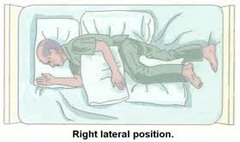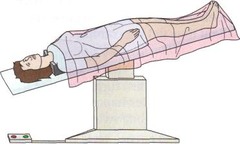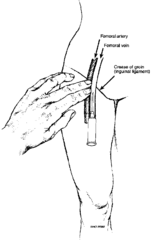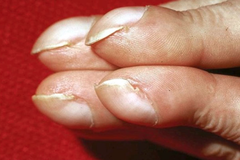Nursing Interventions Exam 1 – Flashcards
Unlock all answers in this set
Unlock answersquestion
Handwashing principles
answer
1. Soap 2. Friction 3. Rinsing 4. Drying 20 seconds
question
Alcohol-based sanitizers
answer
Rub hands for 15 seconds or until dry
question
When to Wash Hands
answer
1. Before/after: patient contact using gloves performing an invasive procedure eating After: sneezing and going to the bathroom
question
PPE
answer
Personal Protective Equipment Protecting oneself from patient
question
Types of PPE
answer
Gloves Gowns Masks Goggles
question
Sequence of Putting on PPE
answer
Wash hands Gowns Masks Goggles Gloves
question
Sequence of Taking off PPE
answer
Gloves Goggles Gown Mask Wash Hands
question
Assessment Techniques
answer
1. Inspection 2. Palpation 3. Percussion 4. Auscultation
question
Inspection
answer
Deliberate systemic observation Using senses (sight, hearing smell)
question
Palpation
answer
Light, moderate, deep touching Notice temperature, texture, swelling, vibration Rules: Warm hands Touch area that hurts last
question
Percussion
answer
Finger functions as a hammer Tone is determined by the density of the material that the sound wave passes through (quiet tone for more dense) Direct, blunt, indirect
question
Percussion notes: Tympany Hyperresonance Resonance Dullness Flatness
answer
Gastric bubble (hollow) Emphysema (extra air) Resonance (normal lungs) Dullness (liver) Flatness (muscle or bone)
question
Auscultation
answer
requires a stethoscope Diaphragm: high pitched sounds (firmly on skin) Bell: low pitched sounds (below) (lightly on skin) Tubing 12-18 inches to minimize distortion
question
Auscultation: Quality of Sounds
answer
Pitch: high to low Loudness: soft to loud Duration: short, medium, long Quality: description (ex. raspy)
question
General Survey
answer
Clues to overall health Observational skills necessary Vital signs, height and weight
question
General Survey: What to Observe for
answer
Signs of distress Stature, build Dressing, grooming Posture, gait, coordination Eye contact Level of consciousness, mood Speech patterns Vision or hearing problems Nutritional state Significant others accompanying patient
question
Bed Making
answer
1. Close curtains for privacy 2. Put a bed rail up and move bed up to elbow length 3. Fold soiled linen into itself - no contact w/ scrubs 4. Blanket and bedspread frequently reused 5. Fanfolding if bed is occupied 6. Think energy conservation for nurse and patient
question
Self-Care
answer
ADLs - Activities of Daily Living IADLs - Instrumental Activities of Daily Living
question
Principles for providing hygeine
answer
Don't assume need for assistance Determine preferences Assess ability to assist Assess activity tolerance Be respectful
question
Factors Affecting Self-Care
answer
Health state Developmental level Socioeconomic status Culture, values, beliefs Personal preferences
question
Therapeutic Effects of Bathing
answer
Cleanses body secretions Stimulates circulation Improves joint mobility Provides opportunity to assess skin Positive interaction Relaxation/comfort Sense of well-being Infection control
question
General Skin Care Principles
answer
Assess skin daily Use pH no rinse cleanser Avoid: Soap and hot water Minimize skin exposure to moisture Use emollients
question
Bedbath
answer
Privacy: put on gloves, draw curtains Bath blanket Expose 1 body at a time Cover wet area
question
Bedbath Sequence
answer
Eyes Abdomen Legs Feet Back (back of legs) Perineum Hair
question
As Needed Care
answer
PRN
question
Ear Care
answer
Cleanse pinna or auricle of the ear Cerumen is removed via capillary action No Q tip
question
Hearing Aids
answer
Wear at intervals to adjust Adjust volume to lowest level needed Check batteries daily Clean ear piece only Feedback noise (whistling) can be distressing
question
Nutrition
answer
Set up assistance: Open cartons Cut food up Food preferences Appropriate utensils Use clock location
question
Feeding a Paitent
answer
Be aware of environment Position upright Mouth care before meal Toilet before meals Provide pain med prn Napkin or bib Dentures, hearing aids, glasses Involve patient Sit at eye level Encourage conversation
question
Perineal Care
answer
Wipe from least dirty to most dirty
question
Dressing a Patient
answer
Strive to maintain independence Dress painful/weak/paralyzed side first
question
Foot Care Considerations
answer
Feet are vulnerable to injury Older Patients with diabetes Poor circulation, decreased sensation, peripheral neuropathy
question
Diabetic Foot and Nail Care
answer
Inspection File nails straight across (no clipping) Do not soak/rub feet vigorously Moisturize skin, not between toes
question
Special Considerations for Feet of Diabetics
answer
Lukewarm water Never trim own calluses or bunions Avoid tight socks/shoes Shake shoes out before putting on Discourage going barefoot
question
Antiembolism Stockings (TEDS)
answer
Type of compression stocking Prevents deep vein thrombosis (prevents edema and venous stasis) Exerts 15 mmHG pressure
question
TEDS: care considerations
answer
Correct fit Avoid wrinkles Put on in morning Remove for 30 minutes
question
Nursing Diagnosis
answer
Bathing/Hygiene Impaired oral mucous membrane Dressing/grooming Toileting Feeding Impaired social interaction Caregiver role strain Altered family processes Ineffective coping
question
Pain
answer
Known as the 5th vital sign Subjective experience Highly individual Expression of pain might not be consistent with degree of pain
question
The Joint Commission
answer
Patients have the right to effective pain management Published standards Care plan is based on mutually set goals to reduce or eliminate pain
question
Duration of Pain
answer
Acute Chronic Acute on chronic Remission and exacerbation
question
Source of Pain
answer
Cutaneous or superficial Somatic (skin and deep tissue) Visceral (organ pain - can be vague or intense)
question
Referred pain
answer
Pain that goes somewhere else because of attached nerves ex. left arm and heart attack right shoulder and gallbladder/liver pain
question
Neuropathic pain
answer
Abnormal functioning of nerve pathway Tingling/burning
question
Intractable pain
answer
Unrelieved pain
question
Phantom pain
answer
Amputation of limb and still feel pain in area
question
Responses to Pain
answer
Voluntary behavioral Involuntary physiologic Psychological responses
question
Involuntary physiologic responses
answer
Sympathetic responses: increase in HR, increase systolic BP, pupil dilation, diaphoresis (sweat) Parasympathetic responses: decrease in HR, decrease in BP, pupil constriction
question
COLD ERA
answer
Character of complaint Onset of symptom Location of complaint Duration of problem Exacerbated by what Relieved by what Associated symptoms
question
OLD CARTS
answer
Onset Location Duration Character Aggravating factors/symptoms Relieving factors Temporal factors - sequence: coming and going Severity
question
Pain Assessment Tools
answer
Wong Baker Faces Rating Scale 0-10 Numeric pain distress scale Abbey Pain Scale Non-Verbal Pain Scale
question
Pain Relief Measures
answer
Analgesics Non-Pharmalogic: distraction, music, humor, imagery, relaxation, cutaneous stimulation, therapeutic touch
question
Things to Know 2
answer
Define the principles of providing skin care and hygiene. Identify types of hygiene used in patient care. State special hygiene measures for the unresponsive patient Discuss assisting patients with activities of daily living (ADL). Discuss the importance of foot care for the diabetic patient. Identify the purpose and principles for using anti-embolic stockings.
question
Things to Know 1
answer
Recognize handwashing as fundamental to infection control. Identify components of skilled general survey Recognize the link between skilled general survey and patient assessment State purpose of various health assessment techniques Identify the purpose for the use of PPE in the performance of patient care
question
Normal Movement and Alignment
answer
Alignment and posture Balance Coordinated Movements
question
Postural Reflexes
answer
Labyrinth sense: inner ear Proprioreception: awareness of where the body is Visual reflexes Extensor or stretch reflexes - maintaining posture and safety
question
Factors affecting movement and alignment
answer
Physical health: Muscular, skeletal, and nervous system problems Trauma to MS system Problems affecting CNS Respiratory Cardiac Negative nitrogen balance Mental health Lifestyle Attitudes, values External factors
question
Primary benefits of exercise
answer
Increases endurance and lung capacity Decreases pulse, BP, risk of atheroscelrosis Prevents constipation Stimulates appetite Improves sleep quality Strenghtens muscles
question
Isotonic Exercise
answer
Muscle shortens, active movement Increased muscle mass, joint mobility, cardiac and respiratory function, circulation, bone formation ex. running
question
Isokinetic Exercise
answer
Muscle contraction with resistance Constant rate by external device, capacity for variable resistance Helps with joint movement ex. weights on ankles
question
Isometric Exercise
answer
Muscle contraction without shortening Increased muscle mass, tone, strength, circulation, osteoblastic activity ex. yoga pose
question
Fowlers positioning
answer
45-60 degrees
question
Low/Semifowlers
answer
30 degrees
question
Hi-fowlers
answer
Over 80 degrees
question
Supine Positioning
answer
Laying on back
question
Prone Positioning
answer
Laying on stomach
question
Sims Positioning

answer
Lying on side, legs apart, pillow under arm
question
Side-lying Positioning

answer
Legs together, pillow between, arm supported by pillow
question
Trendelenburg Positioning

answer
Head down, feet elevated
question
Consequences of Immobility
answer
Decreased: muscle size, tone, strength, endurance, stability, demineralization, joint mobility, flexibility Increased: risk for contractures with immobility, foot drop, pressure sores
question
Cardiopulmonary Consequences of Immobility
answer
Increased cardiac workload Increased risk for orthostatic hypotension Increased risk for thrombus formation Decreased lung expansion Pooling of secretions Impaired gas exchange
question
Nutrition/Metabolic Consequences of Immobility
answer
Decreased appetite Decreased metabolic rate Impaired immunity
question
Elimination Consequences of Immobility
answer
Constipation Increased risk of urinary stasis Increased risk of renal calculi Decreased smooth muscle tone
question
Psychosocial Consequences of Immobility
answer
Altered mental status Altered sleep-wake pattern Decreased self-concept Decreased social interaction Decreased sensory stimulation Altered roles and relationships Increased risk for depression Increased sense of powerlessness
question
Why are nurses at risk for injury?
answer
Frequency Force Position Duration
question
Key Principles of Body Mechanics
answer
Wide base of support Feet wide, knees bent, back straight Utilize leg muscles Work at proper height Face direction of movement Keep patient as close to body as possible
question
Ambulation Guidelines
answer
Assess for dizziness ; weakness Dangle feet and rest on side of bed before rising Non-slip footwear Gait belt Stand to side and slightly behind
question
Ambulation with a Walker
answer
Place walker directly in front of patient Stand to side and slightly behind Patient moves walker forward, sets it down, steps forward
question
Using Crutches
answer
Standing up Place both crutches on uninjured side Grasp chair arm with other hand Stand up with pressure on uninjured leg Tripod standing position Crutches at a 45 degree angle from feet
question
Ways to Use Crutches
answer
4 pt gait: both legs weak 3 pt: 1 leg weight bearing 2 pt: both legs weak Swing through gait: 1 leg weight bearing Swing to gait: paraplegic
question
Using crutches on stairs
answer
Up with the good, down with the bad UP: step up with stronger leg, step up with weaker leg, bring crutches up DOWN: put crutches on next step, step down with weaker leg, step down with stronger leg
question
Ambulation Using a Cane
answer
Single pronged, 4 pronged Hold cane on stronger side close to body Nurse stands on weaker side and slightly behind Cane opposite affected leg
question
Things to Know 3
answer
Use examination techniques appropriately to perform a musculoskeletal and neurological assessment. Use the MMSE appropriately assess mental status. Use examination techniques appropriately to assess cranial nerves VIII and IX. Begin to interpret musculoskeletal and neurological physical examination findings.
question
The Physical Assessment
answer
Gathering relevant history Mental status evaluation Cranial nerve testing Sensory testing Motor Testing Reflexes
question
Assessing Mental Status
answer
Level of awareness A;O x3: Person, place, time Awake and alert lethargic stuporous comatose - no response
question
Glasgow coma scale
answer
LOC - level of consciousness Higher # - more alert the patient is As # goes down, less conscious
question
MMSE
answer
Mini Mental Status Exam Assess cognitive mental status Follow course of an illness Monitor response to treatment Possible score of 30 - higher the better Orientation, registration, recall, calculation and attention, language
question
MMSE: Orientation
answer
Year, month, date, day, time (5) State, Country, Town, Building, Floor (5)
question
MMSE: Registration
answer
Name 3 objects Use 1 second interval Ask patient to repeat the objects (1 point for each correct)
question
MMSE: Attention and Calculation
answer
Serial 7's Spell "World" backwards (1 point for each correct)
question
MMSE: Recall
answer
Repeat 3 object previously learned (1 point for each correct)
question
MMSE: Language
answer
Ask patient to identify 2 objects (1 point for each correct) Repeat "No if, ands, or buts" (1 point if correct) Ask patient to follow 3 step command: "Take paper in your right hand, fold it in half, and put it on the floor" (1 point for each correct action) Write "close your eyes" on a piece of paper, hand it to the patient and ask them to obey the sentence (1 point if correct) Write a sentence (1 point if has a subject and a verb) Ask the patient to copy a design of intersecting pentagons (1 point if correct)
question
Cranial Nerves
answer
Olfactory Optic Oculomotor Trochlear Trigeminal Abudcens Facial Acoustic Glossopharyngeal Vagus Spinal Accessory Hypoglossal
question
Cranial Nerve VII: Acoustic
answer
Test for balance Romberg Test: Have patient stand with heels together, arms at side and eyes closed Losing Balance: positive test + test: cerebellar dysfunction, vestibular dysfunction, or sensory deficit Whisper test: block one ear while someone whispers in the other
question
Cranial Nerve XI: Spinal Accessory
answer
Inspect atrophy or asymmetry of the trapezius and sternocleidomastoid muscles Test for strength - check resistance
question
Deep Tendon Reflexes
answer
Reflex depends on the force of stimulus Tendon Reflex Grading Scale 0 no response 1+ low normal, somewhat diminished 2+ normal, average 3+ brisker than average 4+ very brisk, hyperactive, indicative of disease
question
Assessing the Knee Reflex
answer
Have the patient sit with the lower leg hanging freely off of the bench Strike the quadriceps tendon just below the patella Quadriceps and extension of the knee
question
Hypertrophy
answer
Increase in muscle mass
question
Atrophy
answer
Decrease in muscle mass
question
Flaccidity
answer
Decreased muscle tone
question
Spasticity
answer
Increased muscle tone
question
Assessing Gait
answer
Walk across the room and back Heel to toe in a straight line Walk on toes in a straight line Wak on their heels in a straight line Rise from a sitting position
question
Abduction
answer
Motion in which the body part is moved away from the body
question
Adduction
answer
Motion in which the body part is moved toward the midline of the body
question
Crepitus
answer
A cracking sound heard in the joint when dry synovial surfaces rub together
question
Plantar
answer
Down (plants grow down in the ground so flex down)
question
Dorsi
answer
Up (flex up)
question
Dorsiflexion
answer
Moving body part towards the dorsum when the ankle moves up toward leg, toes point to ceiling
question
Eversion
answer
Turning outward
question
Extension
answer
Increase in the angle of a joint between two bones
question
External rotation
answer
Rotation of a joint outward
question
Flexion
answer
Motion involved in a decrease in the angle of a joint between two bones
question
Hyperextension
answer
Extending beyond the specified neutral position
question
Internal rotation
answer
Rotation of a joint inward
question
Inversion
answer
Turning inward
question
Lateral
answer
The area toward the outer aspect of the body, away from midline
question
Medial
answer
Area nearest the midline of the body
question
Plantar flexion
answer
Motion of the ankle moving the foot/toes downward
question
Pronation
answer
Movement of the forearm leading to a palm down movement
question
Supination
answer
Movement of the forearm leading to a palm up movement
question
Musculoskeletal Assessment
answer
Normal level of function Acute/chronic mobility problems
question
Cardinal signs of musculoskeletal disease
answer
Pain Redness Swelling Increased warmth Deformity Loss of function
question
MS Inspection
answer
Note position and alignment of body Ability to stand erect; posture Symmetry of body parts; compare contralateral side Note discolorations, swelling, masses Appearance of muscles Muscle tone Fasiculations, spasms
question
MS Palpation
answer
Feel tone of muscle (flaccid, spastic, good) Note tenderness, heat, swelling, crepitus Assess range of motion Test strength
question
Active Range of Motion
answer
Ask patient to move each joint through full range of motion Note degree and type of any limitations Increased or decreased range of motion of instability Compare with other side
question
Passive Range of Motion (PROM)
answer
Support the major joints of the extremity Gently move joint through its full range of motion Note degree and type limitation: pain or mechanical Compare with other side
question
Muscle Strength
answer
0: no muscle contraction 1: trace contraction 2: actively move muscle w/help 3: can move muscle, not against resistance 4: may move muscle against some resistance, weak 5: moves muscle, overcomes resistance of examiner (normal)
question
Cervical Spine
answer
Note alignment and symmetry of skin folds Palpate posterior neck, cervical spine, area muscles ROM: flexion/extension/lateral bending right/left rotation CN XI
question
Shoulders
answer
Inspect contour, clavicle, scapulae Palpate joints ROM: shrug shoulders, forward flexion and hyper extension, internal/external rotation, abduction/adduction
question
Hips
answer
Inspect while patient stands Symmetry of iliac crests, greater trochanter of femur, gluteal folds Palpate for instability, tenderness, crepitus ROM: flexion, hyperextension, abduction, adduction, internal, external rotation
question
Vital Signs
answer
1. Temperature 2. Pulse 3. Respiration Rate 4. Blood Pressure O2 saturation 5th: Pain
question
Baseline Information
answer
Usual measured vital signs Important to monitor changes in trends
question
Body Temperature
answer
Core Body Temperature Range 97.0-99.5 (36-37 degrees Celsius) Rectal temperature, tympanic temperature
question
Body Temperature Regulation
answer
Homeostasis and set point Heat production Heat loss
question
Factors that Affect Body Temperature
answer
Circadian rhythm Age Gender Environmental Temperature Increases in metabolic rate (exercise, stress, illness)
question
Febrile
answer
Temperature above normal Signals infection and increased immune function
question
Afebrile
answer
Normal temperature
question
Hypothermia
answer
Body temperature below normal
question
Decreased Temperature regulation
answer
Older adults Premature infants Immunocompromised status
question
Oral Temperature
answer
98.6 37.0 (101 is indicative of infection)
question
Tympanic Temperature
answer
99.5 37.5
question
Rectal Temperature
answer
99.5 37.5 Use lubricant, ask patient to relax
question
Axillary
answer
97.7 36.5
question
Forehead/Temporal
answer
98.6 37.0
question
Nursing Interventions for Febrile Patients
answer
Monitor temperature Monitor pulse, respirations, BP Fluid intake and output Monitor for seizure activity Administer antipyretic IV fluids Ice bag to axilla and groin
question
Types of Thermometers
answer
Glass (mercury free) Digital Tympanic membrane Temporal artery Disposable paper (Temp-A-Dot) Temperature sensitive strips
question
NANDA Nursing Diagnosis: Temperature
answer
Hyperthermia Hypothermia Risk for imbalanced Ineffective thermoregulation
question
Pulse Rate
answer
Indirect measurement of how well heart is pumping to the body
question
Factors Affecting Heart Rate
answer
Age (high - young, slow - old) Autonomic Nervous system Sympathetic Nervous System (increases) Parasympathetic Nervous System (decreases) Medication Hydration
question
Normal HR
answer
60-100
question
Tachycardia
answer
Fast Over 100 BPM
question
Bradycardia
answer
Slow HR Under 60 BPM
question
Rhythm of Heart
answer
Regular Dysrhythmias (regularly irregular, irregularly irregular)
question
Characteristics of a Pulse
answer
0 absent, unable to palpitate +1 diminished +2 brisk, normal +3 bounding
question
Cardiac Output
answer
HRxSV
question
Peripheral Pulse Sites: Upper Body
answer
Temporal Carotid Apical Brachial Radial
question
Peripheral Pulse Sites: Lower Body

answer
Femoral Popliteal Dorsalis pedis - Pedal (on top of foot) Posterior tibial (inner ankle)
question
Doppler Ultrasound
answer
Amplifies sound waves: used to assess pulses that are difficult to hear The device Handheld probe Conduction gel
question
Pulse Documentation
answer
Rate, rhythm, quality, location
question
NANSA Nursing Diagnoses: Pulse
answer
Decreased Cardiac output Ineffective tissue perfusion Deficient fluid volume Acute pain
question
Respirations
answer
1 breath in, 1 breath out
question
Factors that Affect Respiration
answer
Age Gender Stress/anxiety Exercise Acid-base balance Medications Altitude Pain Anemia Fever Respiratory Diseases
question
Counting Respirations
answer
Count for 15 seconds, multiply by 4 If irregular, count for 1 min
question
Respiration Interpretation #
answer
12-20 breaths/minute
question
Tachypnea
answer
Over 20 breaths, shallow
question
Bradypnea
answer
Less than 12 breath, regular depth
question
Apnea
answer
No breathing
question
Respiration Quality
answer
Unlabored Quiet Effortless Labored Shallow Deep Gasping Painful
question
NANDA Nursing Diagnoses: Respiration
answer
Ineffective breathing patterns Impaired gas exchange Risk for activity intolerance
question
Factors Affecting Blood Pressure
answer
Age Circadian rhythm Food intake Exercise Weight Emotional Body position Race Medication
question
Korotkoff Sounds
answer
5 Separate phases Systolic Diastolic
question
Blood Pressure Measurement
answer
Rested for 5 minutes Has not consumed caffeine Has not smoked for 30 minutes Sitting in a straight back chair Feet resting on ground Arm supported at heart level Patient is quiet
question
Obtaining an Accurate Reading
answer
Cuff size Can give false low or high
question
Taking a Blood Pressure
answer
Support arm at heart level Locate the brachial artery Medial aspect of antecubital fossa Wrap cuff with bladder centered over artery and 1-2 inches above the antecubital fossa Line artery marking on cuff up with brachial artery Tubing should extend near the elbow Close cuff valve by turning clockwise and palpate the brachial or radial artery while inflating cuff When you no longer feel the pulse, note the pressure and deflate cuff Wait 15 seconds Place stethoscope over brachial artery and reinflate the cuff to 30 mmHG above palpated pressure Deflate cuff at rate of 2-3 mm per second Note manometer reading when first clear sound is heard Note manometer reading when sound disappears Document as systolic/diastolic noting RA or LA (right or left arm) If you have to retake BP, wait 2 minutes Specify if R or L arm
question
Blood pressure 18-59
answer
140/90
question
Blood pressure 60 DM, Kidney Disease
answer
140/90
question
Blood pressure 60 or older
answer
150/90
question
BP #s Important
answer
How hard heart has to work to pump
question
Pulse Pressure
answer
Difference between systolic and diastolic reading Reflects how stiff or resistant the arteries are (can be hardening of arteries w/plaque) Higher PP more resistance Determined by: SV, aortic artery compliance
question
Orthostatic Hypotension
answer
Decrease in BP from standing
question
Pulse Oximetry
answer
SpO2: 95-100%: Normal SpO2: <90: Need for O2
question
Serial Weights
answer
Usually same time each day Before breakfast, after voiding
question
Tracing Blood Through the Heart
answer
Superior/inferior vena cava Right atrium Tricuspid/AV valve Right ventricle Pulmonary/semilunar valve Pulmonary artery Pulmonary veins Left atrium Semilunar valve Left ventricle Aortic Valve Aorta
question
Systole
answer
Ventricles contract AV valves close: 1st heart sound
question
Diastole
answer
Ventricles fill Opening of AV valves Semilunar valves close: 2nd heart sound
question
Factors that Effect CV Status
answer
High BP Obesity Smoking Lack of Exercise Diet
question
Cardiovascular Focused Interview Assessment
answer
Fatigue Distress Chest Family history Medication history Activity level Weight (gains, losses) 1 kg: 1 L fluid
question
BMI
answer
<18.5 kg/m2 = underweight 18.5-24.9 kg/m2 = normal weight 25-29.9 kg/m2 = overweight 30 kg/m2 or higher = obese
question
Waist circumference
answer
Increased risk of DM, dyslipidemia, HTN and CVD with: Women > 35 inches Men > 40 inches
question
% weight change calculation
answer
Usual-present/usual x100
question
Dietary Habits and CV
answer
Calories/day (gender, height, weight, activity level) Sodium intake (2300-1500 mg) Fat intake 20-35% cal (poly, mono)
question
Lipids
answer
Triglycerides (TGs) <150 mg/dL CHOL levels Total CHOL < 200mg/dL LDL 60 mg/dL Screening every 5 yrs starting at age 20
question
Smoking and CV Assessment
answer
Type of tobacco Pack years: #years x #packs
question
Alcohol and CV Assessment
answer
Consumption guidelines Risk factors for women w/elders 1/day or m 2/day
question
CV Inspection

answer
Skin color, lips, nail beds (capillary refill) Body position - tripod Finger clubbing Nasal flaring Anxiousness/restlessness Breathing (rate, depth, effort, pursed lips)
question
Sternocleidomastoid Muscle Trapezius Muscle
answer
Attach to the manubrium of the sternum and to clavicle Arises from occipital bone in head and all the throacic vertebrae
question
Pulse deficit
answer
Difference between apical and radial pulse rates
question
SBAR
answer
Situation Background Assessment Recommendation
question
S: Situation
answer
Describe situation ID caller's name, status, unit, patient's name, room # State reason for call in 1 sentence
question
B: Background
answer
Concise history What led to situation Diagnosis Date admitted Meds, allergies, IV fluid Vital signs Labs Code status
question
A: Assessment
answer
What you think is happening in the situation
question
R: Recommendation
answer
The course of action you expect to happen



